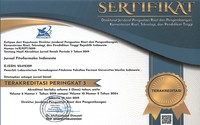Antioxidant Activity Test for Button Mushroom (Agaricus bisporus) Ethanol Extract Using The FRAP Method (Ferric Reducing Antioxidant Power)
Abstract
Keywords
Full Text:
PDFReferences
Betteridge, D.J. (2000) ‘What is oxidative stress?’, Metabolism: clinical and experimental, 49(2 Suppl 1), pp. 3–8. Available at: https://doi.org/10.1016/s0026-0495(00)80077-3.
Chew, Y.L. et al. (2008) ‘Antioxidant activity of three edible seaweeds from two areas in South East Asia’, LWT-Food Science and Technology, 41(6), pp. 1067–1072.
Falguera, V. et al. (2011) ‘Inhibitory effect of melanins from Agaricus bisporus polyphenol oxidase and two different substrates on carboxypeptidases A and B activity’, European Food Research and Technology, 233, pp. 1075–1079.
Halvorsen, B.L. et al. (2002) ‘A systematic screening of total antioxidants in dietary plants’, The Journal of nutrition, 132(3), pp. 461–471.
Kochhar, S.P. and Rossell, J.B. (1990) ‘Detection, estimation and evaluation of antioxidants in food systems’, in Food antioxidants. Springer, pp. 19–64.
Mamonto, S.I. (2014) ‘Aktivitas antioksidan ekstrak kulit biji buah pinang yaki (Areca vestiaria giseke) yang di ekstraksi secara soklet’, Pharmacon, 3(3).
Maryam, S., Baits, M. and Nadia, A. (2015) ‘Pengukuran aktivitas antioksidan ekstrak etanol daun kelor (Moringa oleifera Lam.) menggunakan metode FRAP (Ferric Reducing Antioxidant Power)’, Jurnal Fitofarmaka Indonesia, 2(2), pp. 115–118.
Muchroji., dan C.Y.A. (2004) ‘Budidaya Jamur Kuping’, in. PT. Penebar Swadaya, p. 29.
Rahmawati, S.I. (2017) ‘Jamur Sebagai Obat’, Jurnal Agroindustri Halal, 1((1)), p. (1), 014–024. Available at: https://doi.org/https://doi.org/10.30997/jah.v1i1.361.
Sadler, M. (2003) ‘Nutritional properties of edible fungi’, Nutrition Bulletin, pp. 305–308. Available at: https://doi.org/https://doi.org/10.1046/j.1467-3010.2003.00354.x.
Winarsih, H. (2007) Antioksidan Alami Dan Radikal Bebas, Kanisius. Kanisius, Yogyakarta.
DOI: https://doi.org/10.33096/jffi.v10i3.1104
Copyright (c) 2023 Asriani Suhaenah, Muzakkir Baits, Normawati Ismail

This work is licensed under a Creative Commons Attribution-ShareAlike 4.0 International License.
Indexed by:
ISSN: 2356-0398 | e-ISSN: 2541-2329
Editor's Address:
Third Floor Pharmacognosy-phytochemistry laboratory building, Urip Sumoharjo road km. 5 Campus II UMI, Makassar, South Sulawesi, Indonesia
Phone: +6281524045514
Fax: +62411425619
E-mail: editorjfi@umi.ac.id

















.jpg)

